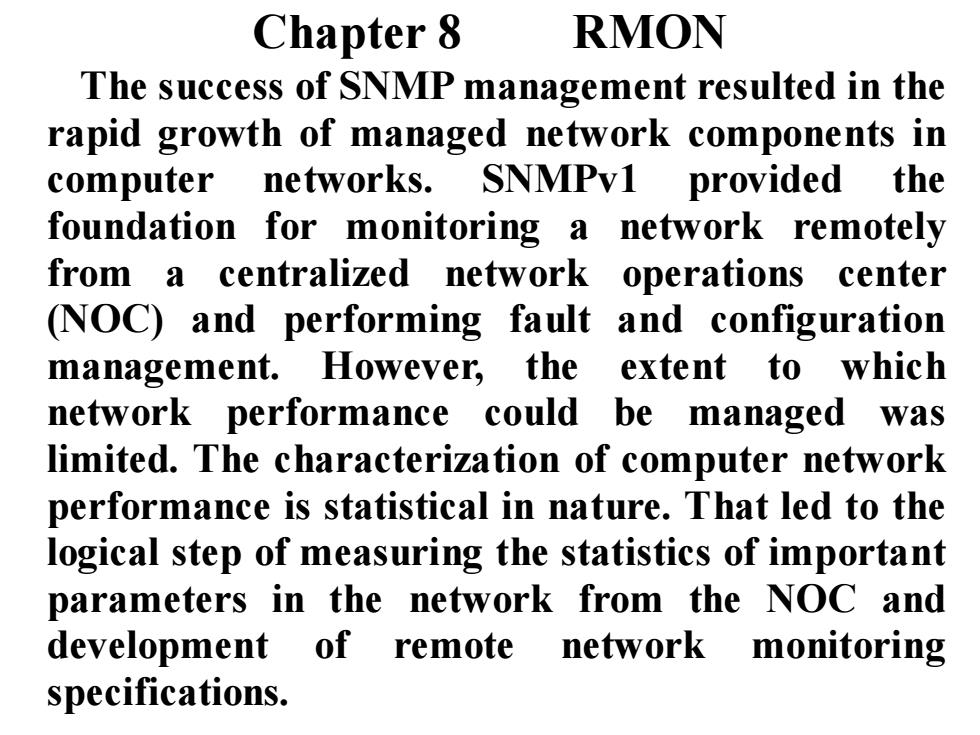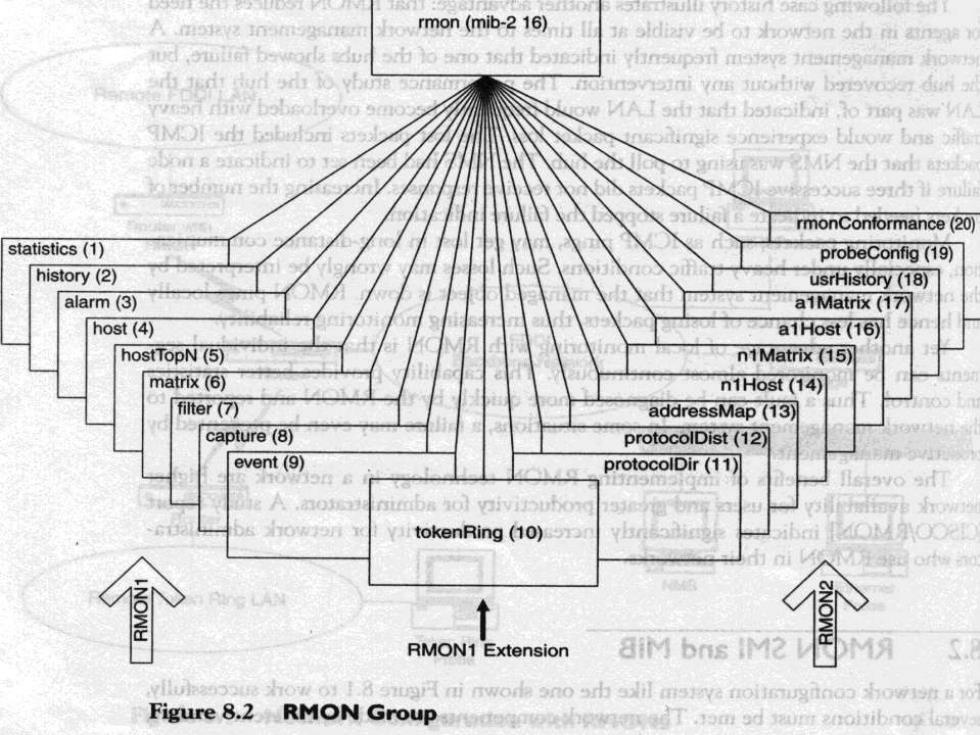
Chapter 8 RMON The success of SNMP management resulted in the rapid growth of managed network components in computer networks.SNMPy1 provided the foundation for monitoring a network remotely from a centralized network operations center (NOC)and performing fault and configuration management.However,the extent to which network performance could be managed was limited.The characterization of computer network performance is statistical in nature.That led to the logical step of measuring the statistics of important parameters in the network from the NOC and development of remote network monitoring specifications
Chapter 8 RMON The success of SNMP management resulted in the rapid growth of managed network components in computer networks. SNMPv1 provided the foundation for monitoring a network remotely from a centralized network operations center (NOC) and performing fault and configuration management. However, the extent to which network performance could be managed was limited. The characterization of computer network performance is statistical in nature. That led to the logical step of measuring the statistics of important parameters in the network from the NOC and development of remote network monitoring specifications

8.1 What Is Remote Monitoring? In Chapter 5 we gave some examples of SNMP messages going across a network between a manager and an agent.We did so with a tool that "sniffs" every packet going across a LAN,opens it,and analyzes it.It is a passive operation and does nothing to the packets,which continue on to their destinations. This approach is called monitoring (or probing)the network,and the device that performs that function is called a network monitor (or probe).We need to make a distinction between the two components of a probe:(1)the physical object that is connected to the transmission medium,and (2)the processor that analyzes the data.If both are at the same place geographically,the probe is local,which is how sniffers used to function
8.1 What Is Remote Monitoring? In Chapter 5 we gave some examples of SNMP messages going across a network between a manager and an agent. We did so with a tool that "sniffs" every packet going across a LAN, opens it, and analyzes it. It is a passive operation and does nothing to the packets, which continue on to their destinations. This approach is called monitoring (or probing) the network, and the device that performs that function is called a network monitor (or probe). We need to make a distinction between the two components of a probe: (1) the physical object that is connected to the transmission medium, and (2) the processor that analyzes the data. If both are at the same place geographically, the probe is local, which is how sniffers used to function

Remote FDDI LAN Router with RMON FDDI Probe FDDI Backbone Network Router Bridge Router NMS Remote Token Ring LAN Ethernet Probe Token Ring Probe Figure 8.1 Network Configuration with RMONs

Chapter 8 RMON 8.2 RMON SMI and MIB RMON MIB which defines RMON groups has been developed in three stages.The original RMON MIB, now referred to as RMON1,was developed for the Ethernet LAN in November 1991 [RFC 1271],but it was made obsolete in 1995 [RFC 1757].Token ring extensions to RMON1 were developed in September 1993 RFC 1513].The use of RMONI for remote monitoring was extremely beneficial,but RMONI addressed parameters at the OSI layer 2 only.Hence RMON2 [RFC 2021]was developed and released in January 1997;it addressed the parameters associated with OSI layers 3-7. The RMON group is node 16 under MIB-II (mib-2 16).All the groups are shown in Figure 8.2
Chapter 8 RMON 8.2 RMON SMI and MIB RMON MIB which defines RMON groups has been developed in three stages. The original RMON MIB, now referred to as RMON1, was developed for the Ethernet LAN in November 1991 [RFC 1271], but it was made obsolete in 1995 [RFC 1757]. Token ring extensions to RMON1 were developed in September 1993 [RFC 1513]. The use of RMON1 for remote monitoring was extremely beneficial, but RMON1 addressed parameters at the OSI layer 2 only. Hence RMON2 [RFC 2021] was developed and released in January 1997; it addressed the parameters associated with OSI layers 3-7. The RMON group is node 16 under MIB-II (mib-2 16). All the groups are shown in Figure 8.2

rmon (mib-2 16) rmonConformance(20) statistics(1) probeConfig(19) history(2) usrHistory (18) alarm(3) a1Matrix(17) host(4) a1Host(16) hostTopN(5) n1Matrix (15) matrix(6) n1Host(14) filter (7) addressMap (13) capture(8) protocolDist(12) event(g)】 protocolDir(11) e A itokenRing(10) A RMON1 Extension 8iM bns IM2 3sy用woe9n0hsis2o6ug1n0o0g1地B Figure 8.2 RMON GroupTd